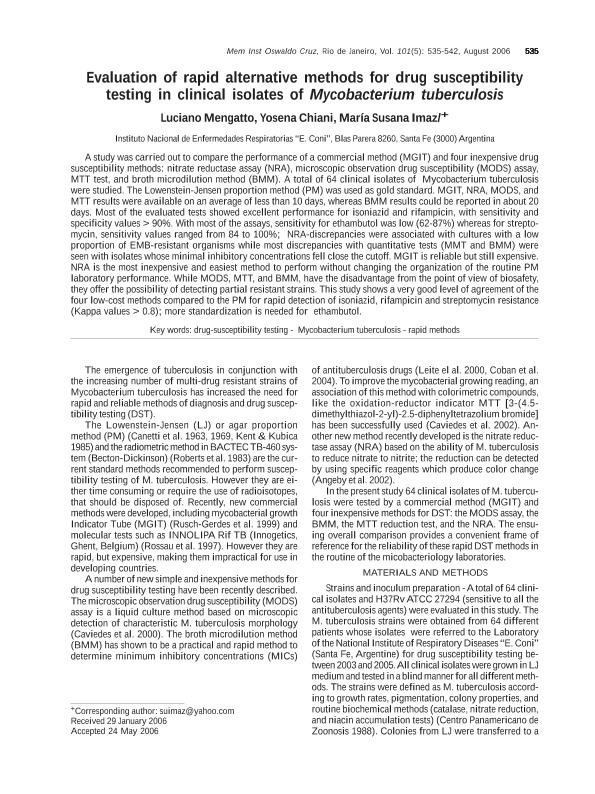Artículo
Evaluation of rapid alternative methods for drug susceptibility testing in clinical isolates of Mycobacterium tuberculosis
Fecha de publicación:
08/2006
Editorial:
Fundacao Oswaldo Cruz
Revista:
Memórias do Instituto Oswaldo Cruz
ISSN:
0074-0276
e-ISSN:
1678-8060
Idioma:
Inglés
Tipo de recurso:
Artículo publicado
Clasificación temática:
Resumen
A study was carried out to compare the performance of a commercial method (MGIT) and four inexpensive drug susceptibility methods: nitrate reductase assay (NRA), microscopic observation drug susceptibility (MODS) assay, MTT test, and broth microdilution method (BMM). A total of 64 clinical isolates of Mycobacterium tuberculosis were studied. The Lowenstein-Jensen proportion method (PM) was used as gold standard. MGIT, NRA, MODS, and MTT results were available on an average of less than 10 days, whereas BMM results could be reported in about 20 days. Most of the evaluated tests showed excellent performance for isoniazid and rifampicin, with sensitivity and specificity values > 90%. With most of the assays, sensitivity for ethambutol was low (62-87%) whereas for streptomycin,sensitivity values ranged from 84 to 100%; NRA-discrepancies were associated with cultures with a low proportion of EMB-resistant organisms while most discrepancies with quantitative tests (MMT and BMM) were seen with isolates whose minimal inhibitory concentrations fell close the cutoff. MGIT is reliable but still expensive. NRA is the most inexpensive and easiest method to perform without changing the organization of the routine PM laboratory performance. While MODS, MTT, and BMM, have the disadvantage from the point of view of biosafety,they offer the possibility of detecting partial resistant strains. This study shows a very good level of agreement of the four low-cost methods compared to the PM for rapid detection of isoniazid, rifampicin and streptomycin resistance (Kappa values > 0.8); more standardization is needed for ethambutol.Mycobacterium tuberculosis were studied. The Lowenstein-Jensen proportion method (PM) was used as gold standard. MGIT, NRA, MODS, and MTT results were available on an average of less than 10 days, whereas BMM results could be reported in about 20 days. Most of the evaluated tests showed excellent performance for isoniazid and rifampicin, with sensitivity and specificity values > 90%. With most of the assays, sensitivity for ethambutol was low (62-87%) whereas for streptomycin,sensitivity values ranged from 84 to 100%; NRA-discrepancies were associated with cultures with a low proportion of EMB-resistant organisms while most discrepancies with quantitative tests (MMT and BMM) were seen with isolates whose minimal inhibitory concentrations fell close the cutoff. MGIT is reliable but still expensive. NRA is the most inexpensive and easiest method to perform without changing the organization of the routine PM laboratory performance. While MODS, MTT, and BMM, have the disadvantage from the point of view of biosafety,they offer the possibility of detecting partial resistant strains. This study shows a very good level of agreement of the four low-cost methods compared to the PM for rapid detection of isoniazid, rifampicin and streptomycin resistance (Kappa values > 0.8); more standardization is needed for ethambutol.
Palabras clave:
Drug Susceptibility Testing
,
Mycobacterium Tuberculosis
,
Rapid Methods
Archivos asociados
Licencia
Identificadores
Colecciones
Articulos(INTEC)
Articulos de INST.DE DES.TECNOL.PARA LA IND.QUIMICA (I)
Articulos de INST.DE DES.TECNOL.PARA LA IND.QUIMICA (I)
Citación
Mengatto, Luciano Nicolas; Chiani, Yosena; Imaz, Maria Susana; Evaluation of rapid alternative methods for drug susceptibility testing in clinical isolates of Mycobacterium tuberculosis; Fundacao Oswaldo Cruz; Memórias do Instituto Oswaldo Cruz; 101; 5; 8-2006; 535-542
Compartir
Altmétricas




